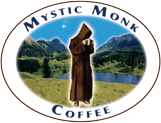Your Cart is Empty
Cowboy Blend and Breakfast blend are great and our go to for a morning cup-o-Joe. But the Holiday blend (whole bean) has been our favorite! Need to stock up when it comes back into season! STRONGLY suggest Mystic Monk Coffee.
just as satisfying as the dark roasts I usually drink
Best decaf coffee I ever have had. Been a subscriber for years, and brother monks are very nice, patient, and accommodating to my changing schedules of delivery.
Thank you very much Mystic Monk❤️

